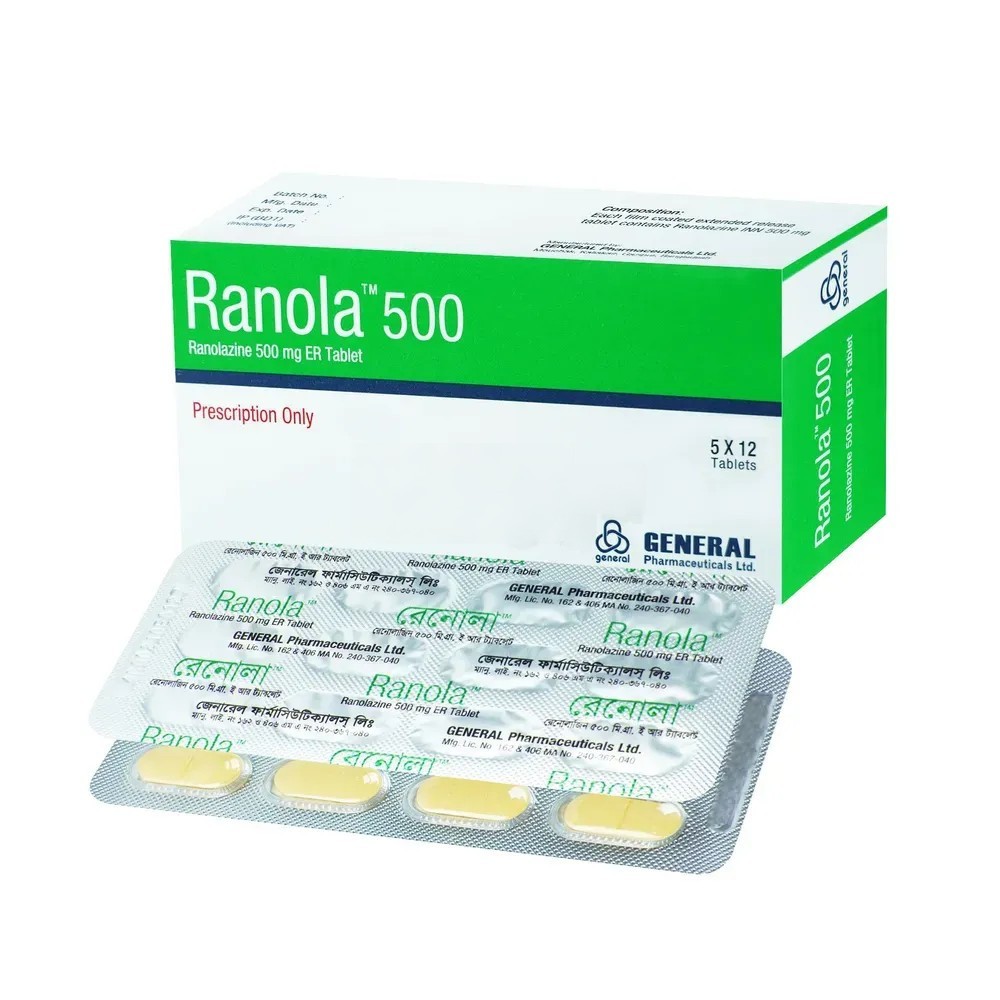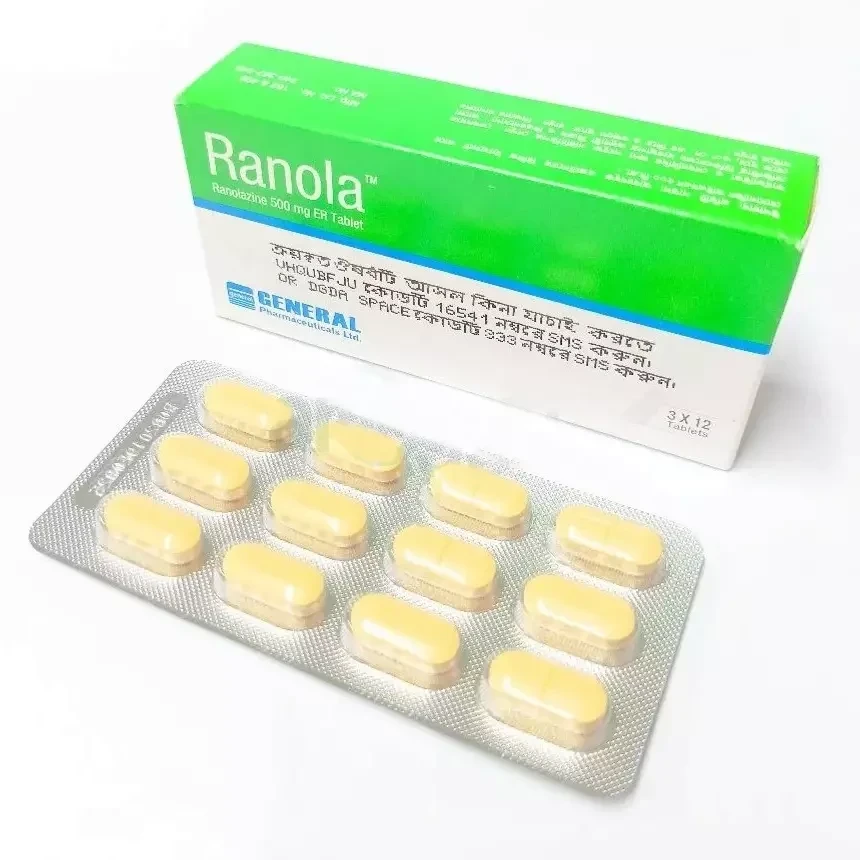



Ranola Tablet (Extended Release), Ranolazine 500 mg
Inhouse product
-
৳11.40
৳12.00 -
৳42.75
৳45.00 -
৳16.63
৳17.50 -
৳2.14
৳2.25
Reviews & Ratings
Indications
Ranola is indicated
for the treatment of chronic angina. Ranola may be used with beta-blockers,
nitrates, calcium channel blockers, anti-platelet therapy, lipid-lowering
therapy, ACE inhibitors, and angiotensin receptor blockers. It has been shown
to decrease angina episodes in patients with coronary artery disease on maximal
doses of amlodipine. Because Ranola prolongs the QT interval, it should be
reserved for patients who have not achieved an adequate response with other
antianginal drugs.The effect on angina rate or exercise tolerance appeared to
be smaller in women than men.
* রেজিস্টার্ড চিকিৎসকের পরামর্শ মোতাবেক ঔষধ সেবন করুন'
Pharmacology
Ranolazine has
anti-ischemlc and antlanginal effects that do not depend upon reductions in
heart rate or blood pressure.The exact mechanism of action of ranolazine is
unknown. Ranolazine at therapeutic levels can inhibit the cardiac late sodium
current (INa). However, the relationship of this inhibition to
angina symptoms is uncertain. The QT prolongation effect of ranolazine on the
surface electrocardiogram is the result of inhibition of IKr which
prolongs the ventricular action potential.
Absorption: Cmax: 2-5 h
Half-life: 6-22 h
Distribution: Over the concentration range of 0.25 to 10
µg/ml, Ranolazine is approximately 62% bound to human plasma proteins.
Metabolism and
Excretion: Ranolazine is
metabolized mainly by CYP3A and, to a lesser extent, by CYP2D6. Ranolazine is
metabolized rapidly and extensively in the liver and intestine; less than 5% is
excreted unchanged in urine and feces. Following a single oral dose of
Ranolazine solution, approximately 75% of the dose is excreted in urine and 25%
in feces.
Dosage &
Administration
Initiate Ranolazine
dosing at 500 mg twice daily and increase to 1000 mg twice daily, if needed,
based on clinical symptoms. Take Ranolazine with or without meals. Swallow
Ranolazine tablets whole; do not crush, break or chew. The maximum recommended
daily dose of Ranolazine is 1000 mg twice daily. If a dose of Ranolazine is
missed, take the prescribed dose at the next scheduled time; do not double the
next dose.
Pediatric use: Safety and effectiveness in pediatric patients have not been
established.
* রেজিস্টার্ড চিকিৎসকের পরামর্শ মোতাবেক ঔষধ সেবন করুন'
Interaction
CYP 3A Inhibitors: Do not use Ranola with strong CYP 3A
inhibitors. With moderate CYP 3A inhibitors (e.g., diltiazem, verapamil,
erythromycin) limit maximum dose of Ranola to 500 mg twice daily.
CYP 3A Inducers: Do not use Ranola with inducers.
P-gp Inhibitors (e.g.,
Cyclosporin): May need to lower
the Ranola dose based on clinical dose.
Drugs transported by
P-gp or metabolized by CYP2D6 (eg., digoxin, TCA): May need reduced doses of these drugs when
used with Ranola.
Contraindications
Ranolazine is
contraindicated in patients:
- With pre-existing QT
prolongation
- With hepatic impairment
- Taking QT prolonging drugs
- Taking potent and moderately
potent CYP3A inhibitors such as ketoconazole, itraconazole,
clarithromycin, nefazodone, nelfinavir, ritonavir, indinavir, and saquinavir,
including diltiazem.
Side Effects
- Cardiac Disorders: bradycardia,
palpitations
- Ear and Labyrinth Disorders:
tinnitus, vertigo
- Gastrointestinal Disorders:
abdominal pain, dry mouth, vomiting
- General Disorders and
Administrative Site Adverse Events: peripheral edema
- Respiratory, Thoracic, and
Mediastinal Disorders: dyspnea
- Vascular
Disorders: hypotension, orthostatic hypotension
Pregnancy &
Lactation
Pregnancy Category C.
There are no adequate studies assessing the effect of ranolazine on the
developing fetus. There are no adequate well-controlled studies in pregnant
women. Ranolazine should be used during pregnancy only when the potential
benefit to the patient justifies the potential risk to the fetus.lt is not
known whether ranolazine is excreted in human milk. Because of the potentiality
for serious adverse reactions from ranolazine in nursing infants, a decision
should be made whether to discontinue nursing or to discontinue Ranolazine,
taking into account the importance of the drug to the mother.
Precautions &
Warnings
Ranola blocks QTc and
prolongs the QTc interval in a dose-related manner. Clinical experience in an
acute coronary syndrome population did not show an increased risk of
proarrhythmia or sudden death.
Co-administration of Ranola with digoxin increases the plasma concentrations of
digoxin by approximately 1.5-fold and the dose of digoxin may have to be
reduced accordingly. The dose of other P-gp substrates may have to be reduced
as well when Ranola Is co-admlnistered. Caution should be exercised when
co-adminlstering Ranola with P-gp inhibitors such as ritonavir or cydosporine.
Overdose Effects
High oral doses of
Ranola produce dose-related increases in dizziness, nausea, and vomiting. High
intravenous exposure also produces diplopia, paresthesia, confusion, and
syncope. In addition to general supportive measures, continuous ECG monitoring
may be warranted in the event of overdose. Since Ranola is about 62% bound to
plasma proteins, hemodialysis is unlikely to be effective in clearing Ranola.
Therapeutic Class
Other Anti-anginal
& Anti-ischaemic drugs
Storage Conditions
Keep below 30°C
temperature, away from light & moisture. Keep out of the reach of children.
Frequently Bought Products
Afun Cream, Clotrimazole 1% 10 MG Tube
Navit Capsule, Spirulina 500 mg
Gelora Oral Gel 15gm tube, Miconazole Nitrate 2% w/w
Solo IV Infusion 500ml, Sodium Chloride 0.9%
Nebipres Tablet, Nebivolol Hydrochloride 2.5 mg
Seclo Capsule (Enteric Coated), Omeprazole 20 mg
Silofit Capsule, Silodosin 4 mg
Product Queries (0)
Login Or Registerto submit your questions to seller
Other Questions
No none asked to seller yet
-
৳11.40
৳12.00 -
৳42.75
৳45.00 -
৳16.63
৳17.50 -
৳2.14
৳2.25

















